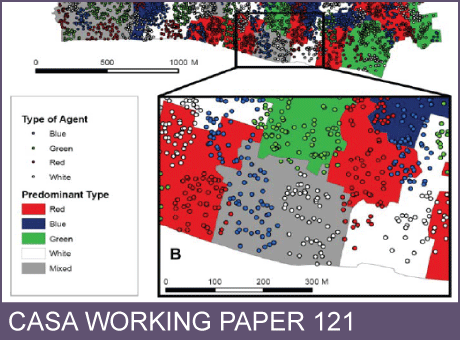CASA Working Paper 121

1 September 2007
Key Challenges in Agent-Based Modelling for Geo-Spatial Simulation
Agent-based modelling (ABM) is fast becoming the dominant paradigm in social simulation due primarily to a worldview that suggests that complex systems emerge from the bottom-up, are highly decentralised, and are composed of a multitude of heterogeneous objects called agents. These agents act with some purpose and their interaction, usually through time and space, generates emergent order, often at higher levels than those at which such agents operate. ABM however raises as many challenges as it seeks to resolve. It is the purpose of this paper to catalogue these challenges and to illustrate them using three somewhat different agent-based models applied to city systems.
The seven challenges we pose involve: the purpose for which the model is built, the extent to which the model is rooted in independent theory, the extent to which the model can be replicated, the ways the model might be verified, calibrated and validated, the way model dynamics are represented in terms of agent interactions, the extent to which the model is operational, and the way the model can be communicated and shared with others. Once catalogued, we then illustrate these challenges with a pedestrian model for emergency evacuation in central London, a hypothetical model of residential segregation tuned to London data which elaborates the standard Schelling (1971) model, and an agent-based residential location built according to spatial interactions principles, calibrated to trip data for Greater London. The ambiguities posed by this new style of modelling are drawn out as conclusions.
This working paper is available as a PDF. The file size is 1995KB.
Authors: Michael Batty, Andrew Crooks, Christian Castle
Publication Date: 1/9/2007
 Close
Close

